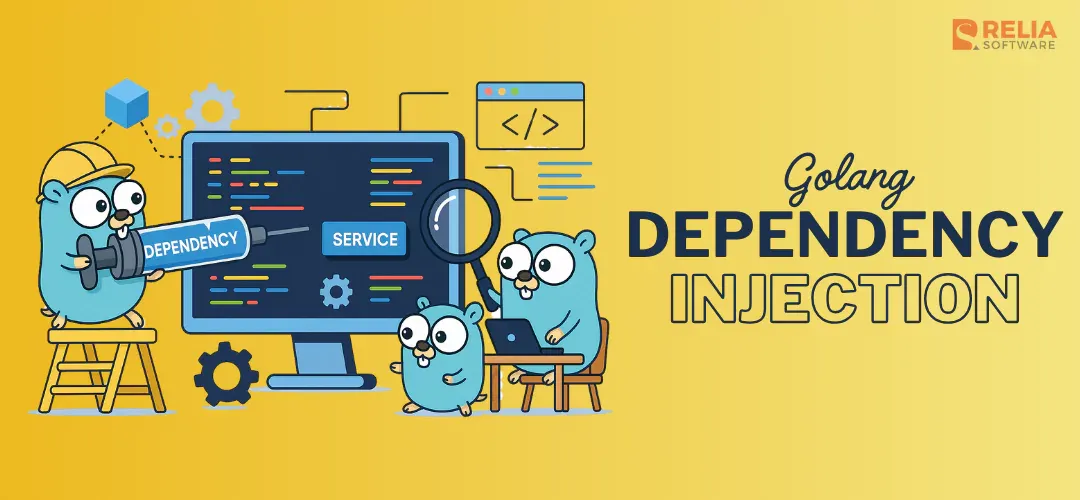>> Read more:
- How Top Companies Achieve Powerful Business Results with Golang?
- Top 10 Best IDEs for Golang Web Development
- [Hands-on Guide] How to Implement Clean Architecture in Golang?
What is Dependency Injection?
Dependency Injection (DI) is a design pattern in software development that helps enhance the modularity, maintainability, and testability of codebases. Its core purpose is to address the challenge of tightly coupled components by enabling the introduction of dependencies from external sources.
This practice is a departure from the conventional approach of components self-creating their dependencies. When applied to Go programming, Dependency Injection offers a structured method for managing dependencies, facilitating the separation of concerns.
Significance of Dependency Injection
The driving force behind adopting Dependency Injection revolves around the concept of inversion of control (IoC). In traditional programming paradigms, components assume the responsibility of generating their dependencies, which often leads to rigid, difficult-to-test code.
With Dependency Injection, the control shifts from components to a specialized DI container, responsible for orchestrating the creation and provisioning of dependencies. This shift towards IoC leads to the development of code that is more modular, reusable, and maintainable.
How Does Dependency Injection in Go Operate?
Within the Go programming language, Dependency Injection involves furnishing a component—typically a struct—with its required dependencies through constructors or methods. Instead of embedding the creation of dependencies within the component itself, Dependency Injection mandates that these dependencies be supplied during the initialization phase.
This approach opens avenues for the effortless substitution of implementations, the seamless mocking of dependencies for testing purposes, and centralized management of the application's configuration.
The Benefits of Dependency Injection in Go
How dependency injection enhances Go applications:
- Modularity: Embracing Dependency Injection nurtures modular design. The encapsulation of each component's functionality, coupled with external dependency injection, enables the isolation, updating, replacement, or expansion of individual components without causing upheaval in the entire application.
- Testability: The adoption of Dependency Injection simplifies the creation of unit tests. Through the injection of mock or stub dependencies, it becomes feasible to isolate the component under examination and ensure that its behavior is scrutinized in isolation. This contributes to the establishment of more robust and predictable tests.
- Reusability: Components that rely on injected dependencies effectively detach from the intricate details of these dependencies. This autonomy bolsters code reusability, as a singular component can be deployed alongside various implementations of its requisite dependencies.
- Maintainability: In the process of application evolution, the manual management of dependencies can swiftly become convoluted. Dependency Injection alleviates this complexity by centralizing the administration of dependencies, simplifying tasks like modification, update, or replacement of dependencies across the application.
- Flexibility: Dependency Injection empowers the switching of dependency implementations sans any alteration to the component's codebase. This feature proves invaluable when experimenting with diverse implementations or when interfacing with third-party libraries.
Dependency Injection vs. Other Design Patterns
Dependency Injection vs. Singleton
Dependency Injection and the Singleton pattern hold divergent aims. While Dependency Injection centers on managing dependencies and fostering decoupling, the Singleton pattern ensures a singular class instance with global access. Dependency Injection's advantage in terms of testability and flexibility stems from its ability to inject varying dependency instances as required.
Dependency Injection vs. Service Locator
Dependency Injection hinges on the explicit conveyance of dependencies, frequently through constructors or methods. In contrast, the Service Locator pattern hinges on a centralized repository accessed by components to retrieve their dependencies. Dependency Injection's transparency and discoverability grant it an edge in terms of code clarity and maintainability.
Dependency Injection vs. Factory
Although both Dependency Injection and Factory patterns handle object creation, their purposes diverge. Dependency Injection centers on offering dependencies to components, while the Factory pattern concentrates on generating instances of intricate objects with specific configurations.
Best Practices in Golang Dependency Injection
Common Mistakes
- Over utilization of Dependency Injection: While Dependency Injection empowers Golang developers, excessive application can convolute the codebase. Prudence is vital; reserve Dependency Injection for components that genuinely benefit from it, while opting for straightforward instantiation elsewhere.
- Injudicious Application of Dependency Injection: Not every element necessitates dependency injection. Overcomplicating simple types with Dependency Injection can counteract its benefits. Employ Dependency Injection judiciously for adaptable and multi-implementation scenarios.
>> Read more:
- Detailed Code Examples of Dependency Inversion Principle in Go
- Best Practices For Dependency Inversion in Golang
Practices for Harnessing Dependency Injection in Go
- Trim the Dependency Count: Maintain a lean dependency set. Strive to only inject dependencies that are crucial for a component's core functionality.
- Embrace Constructor Functions: Constructor functions usher in uniformity and integrity in creating component instances embedded with their dependencies. This consistency ensures dependencies are appropriately configured.
- Champion Interfaces over Concretes: By prioritizing interface injection over concrete types, codebase flexibility and testability flourish. Interfaces permit seamless replacement of implementations without tampering with consuming components.
- Adopt Scope-Driven Dependency Injection: Make judicious choices in dependency scope. Components might require application-wide dependencies or those specific to certain contexts. Leverage dependency injection frameworks with scope management capabilities.
Popular Dependency Injection Frameworks
Google Wire
Google Wire, a compile-time dependency injection framework for Go, leverages code generation to create a container managing the dependency graph. Type safety, scoped instances, interface integration, and automatic dependency resolution are among its offerings.
Pros:
- Type safety via code generation.
- Scoped instances and providers.
- Seamlessly interacts with Go's interfaces.
- Automated resolution of dependencies.
Cons:
- Learning curve tied to code generation.
- Potential build time extensions due to compile-time processing.
- Limited support for resolving circular dependencies.
Uber Dig
Uber Dig, inspired by Google Wire, is another compile-time dependency injection framework. It aims to enhance performance and maintainability in large-scale codebases through efficient code generation and hierarchical dependency management.
Pros:
- Efficient code generation.
- Hierarchical dependency management.
- Scope customization.
- Integration with reflection-based dependency injection.
Cons:
- Learning curve associated with code generation concepts.
- Potential intricacies when setting up hierarchical structures.
- Limited runtime extensibility.
Facebook Inject
Facebook Inject is a runtime reflection-based dependency injection framework for Go. Its reliance on reflection facilitates dynamic injection of dependencies, making it ideal for rapid prototyping and smaller projects.
Pros:
- Dynamic dependency injection.
- User-friendly setup.
- Constructor-based injection support.
- Well-suited for quick prototyping.
Cons:
- Lack of compile-time safety checks.
- Performance overhead linked to reflection in Go.
- Prone to runtime errors if dependencies are misconfigured.
>> You may be interested in:
- Comprehending Arrays and Slices in Go Programming Language
- Type Conversion in Golang: How To Convert Data Types in Go?
Here's a concise comparison of three prominent DI frameworks:
| Framework | Type | Safety | Performance | Flexibility | Ease of Use |
|---|---|---|---|---|---|
| Google Wire | Compile-time | High | Medium | Medium | Moderate |
| Uber Dig | Compile-time | High | Medium | Medium | Moderate |
| Facebook Inject | Runtime | Low | Low | High | High |
Implement Dependency Injection without Frameworks
Dependency Injection can flourish in Go even without dedicated frameworks. Native Go constructs like interfaces, structs, and functions can effectively serve as the foundation for its implementation.
Interfaces
Defining interfaces for dependencies and integrating them within components empowers effortless swapping of implementations:
type Database interface {
Query(sql string) ([]byte, error)
}
type MySQLDatabase struct {
// ...
}
type PostgreSQLDatabase struct {
// ...
}
Structs
By crafting Golang structs that incorporate dependencies and initializing them via constructors, a structured Dependency Injection approach is realized:
type UserService struct {
database Database
}
func NewUserService(db Database) *UserService {
return &UserService{database: db}
}Functions
Functions, too, can be harnessed to accommodate Dependency Injection:
func ProcessData(db Database) error {
// Leverage the database to process data
}Hands-On Practice
In this section, we'll get hands-on experience with dependency injection by building a sample application from scratch. This application will include a Printer interface and two implementations: ConsolePrinter and FilePrinter.
By employing dependency injection, we'll be able to dynamically choose which printer implementation to use based on our needs. Additionally, we'll define a project structure to organize our code effectively.
Building a Sample Application Using Dependency Injection:
Project Structure
To begin, let's set up a well-organized project structure. This will help keep our codebase clean and maintainable:
dependency-injection-sample/
│
├── cmd/
│ └── main.go
│
├── internal/
│ ├── printer/
│ │ ├── printer.go
│ │ ├── console_printer.go
│ │ └── file_printer.go
│ ├── application/
│ │ └── application.go
│ └── config/
│ └── config.go
│
└── test/
└── application_test.go
Now let's delve into the different components of our application:
Defining the Printer Interface and Implementations
printer/printer.go: This file contains the definition of thePrinterinterface.
package printer
type Printer interface {
Print(message string)
}
printer/console_printer.go: Here, we implement the ConsolePrinter type that prints messages to the console.
package printer
import "fmt"
type ConsolePrinter struct{}
func (cp ConsolePrinter) Print(message string) {
fmt.Println("Console Printer:", message)
}
printer/file_printer.go: This file holds the FilePrinter type that prints messages to a file.
package printer
import (
"fmt"
"os"
)
type FilePrinter struct {
FilePath string
}
func (fp FilePrinter) Print(message string) {
fmt.Println("File Printer:", message)
}
Implementing Dependency Injection
application/application.go: This file defines theApplicationstruct and theNewApplicationfunction for dependency injection.
package application
import "printer"
type Application struct {
Printer printer.Printer
}
func NewApplication(printer printer.Printer) *Application {
return &Application{
Printer: printer,
}
}
Main Function
cmd/main.go: Our application's entry point, where we instantiate different printer implementations using dependency injection.
package main
import (
"fmt"
"printer"
"application"
)
func main() {
consolePrinter := printer.ConsolePrinter{}
filePrinter := printer.FilePrinter{FilePath: "output.txt"}
app1 := application.NewApplication(consolePrinter)
app2 := application.NewApplication(filePrinter)
app1.Printer.Print("Hello from App1")
app2.Printer.Print("Hello from App2")
}
Writing Test Cases
test/application_test.go: In this file, we write test cases to validate our application logic and dependency injection.
package test
import (
"testing"
"printer"
"application"
)
func TestApplication_Printer(t *testing.T) {
mockPrinter := &printer.MockPrinter{} // Create a mock printer for testing
app := application.NewApplication(mockPrinter)
expectedMessage := "Test message"
app.Printer.Print(expectedMessage)
if mockPrinter.LastPrintedMessage != expectedMessage {
t.Errorf("Expected '%s', got '%s'", expectedMessage, mockPrinter.LastPrintedMessage)
}
}
Exercises to Reinforce Dependency Injection
To deepen your understanding of dependency injection, take on these exercises:
- Refactor Using Dependency Injection: Choose an existing codebase and refactor it to use dependency injection. Create interfaces for dependencies and inject implementations.
- Write Test Cases: Expand the sample application by adding unit tests. Use mock implementations of the
Printerinterface to validate that theApplicationlogic functions correctly with different printer implementations. - Switch Printer Implementation: Modify the application to allow runtime selection of the printer implementation. This could involve user input or configuration.
By working through these exercises, you'll gain invaluable experience in effectively utilizing dependency injection in real-world scenarios.
Conclusion
In the world of Go programming, Dependency Injection emerges as a potent design pattern, fostering the cultivation of modular, maintainable, and testable code. While prominent DI frameworks such as Google Wire, Uber Dig, and Facebook Inject offer diverse features, it's equally viable to implement Dependency Injection by harnessing native Go constructs like interfaces, structs, and functions.
The optimal path forward—choosing between a framework or a native approach—depends on the project's intricacy, performance prerequisites, and the development team's familiarity with the chosen technology stack.
>>> Follow and Contact Relia Software for more information!
- Mobile App Development
- coding
- golang
- web development

